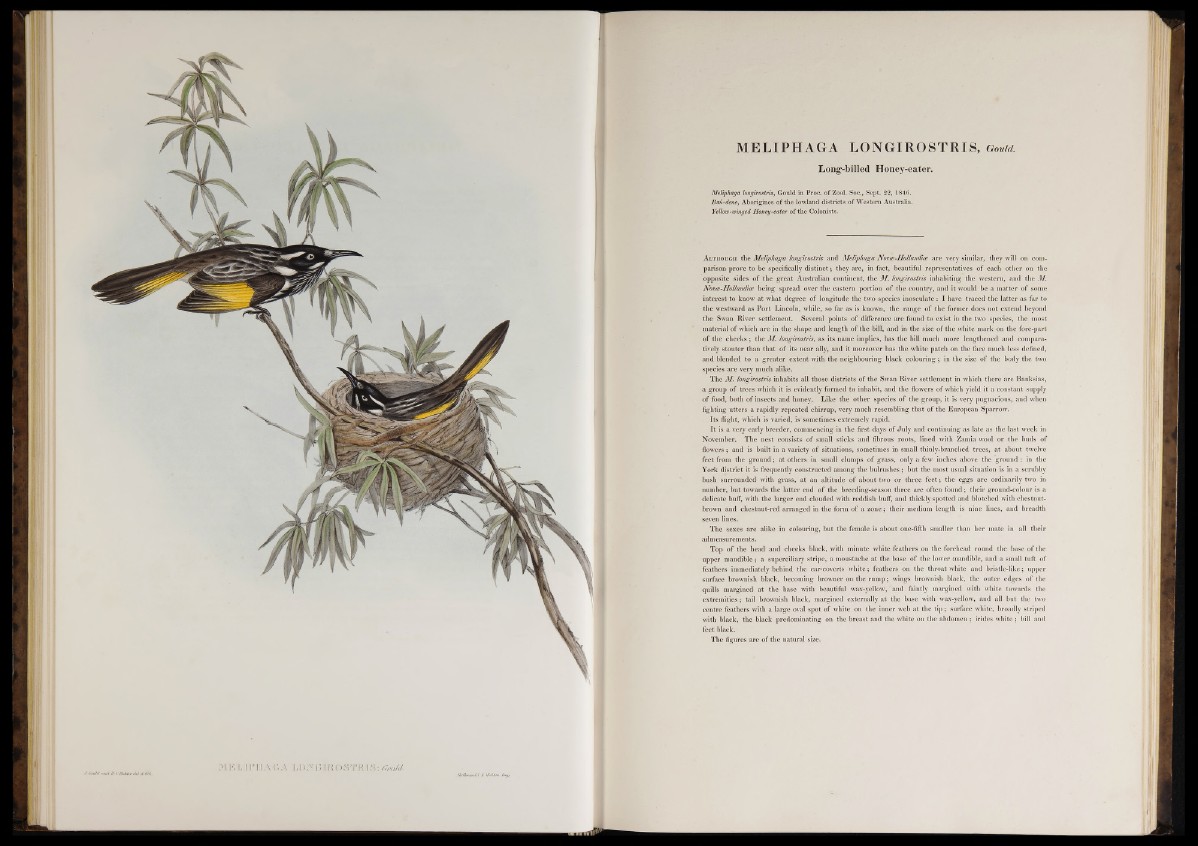
MELIPHAGA LONGIROSTRIS, 1
Long'-billed Honey-eater.
Meliphaga longirostris, Gould in Proc. of Zool. Soc., Sept. 22, 1846.
Ban-dene, Aborigines of the lowland districts of Western Australia.
Yellow-winged Honey-eater of the Colonists.
A l t h o u g h the Meliphaga longirostris and Meliphaga Novce-Hollandice are very similar, they will on comparison
opposite sides of the great Australian continent, the M. longirostris inhabiting the western, and the M.
Novx-Hollandias being spread over the eastern portion of the country, and it would be a matter o f some
interest to know at what degree of longitude the two species inosculate : I have traced the latter as far to
the westward as Port Lincoln, while, so far as is known, the range of the former does not extend beyond
the Swan River settlement. Several points of difference are found to exist in the two species, the most
material o f which are in the shape and length o f the bill, and in the size of the white mark on the fore-part
o f the cheeks ; the M. longirostris, as its name implies, has the bill much more lengthened and comparatively
prove to be specifically distinct ; they are, in fact, beautiful representatives o f each other on the
stouter than that of its near ally, and it moreover has the white patch on the face much less defined,
and blended to a greater extent with the neighbouring black colouring; in the size of the body the two
species are very much alike.
The M. longirostris inhabits all those districts of the Swan River settlement in which there are Banksias,
a group o f trees which it is evidently formed to inhabit, and the flowers o f which yield it a constant supply
o f food, both of insects and honey. Like the other species of the group, it is very pugnacious, and when
fighting utters a rapidly repeated chirrup, very much resembling that of the European Sparrow.
Its flight, which is varied, is sometimes extremely rapid.
It is a very early breeder, commencing in the first days of July and continuing as late as the last week in
November. The nest consists o f small sticks and fibrous roots, lined with Zamia wool or the buds of
flowers ; and is built in a variety o f situations, sometimes in small thinly-branched trees, at about twelve
feet from the ground; at others in small clumps o f grass, only a few inches above the ground: in the
York district it is frequently constructed among the bulrushes; but the most usual situation is in a scrubby
bush surrounded with grass, at an altitude of about two or three fee t; the eggs are ordinarily two in
number, but towards the latter end of the breeding-season three are often found; their ground-colour is a
delicate buff, with the larger end clouded with reddish buff, and thickly spotted and blotched with chestnut-
brown and chestnut-red arranged in the form o f a zone; their medium length is nine lines, and breadth
seven lines.
The sexes are alike in colouring, hut the female is about one-fifth smaller than her mate in all their
admeasurements.
Top of the head and cheeks black, with minute white feathers on the forehead round the base of the
upper mandible; a superciliary stripe, a moustache at the base of the lower -mandible, and a small tuft of
feathers immediately behind the ear-coverts white; feathers on the throat white and bristle-like; upper
surface brownish black, becoming browner on the rump; wings brownish black, the outer edges o f the
quills margined at the base with beautiful wax-yellow, *and faintly margined with white towards the
extremities; tail brownish black, margined externally at the base with wax-yellow, and all but the two
centre feathers with a large oval spot of white on the inner web at the tip ; surface white, broadly striped
with black, the black predominating on the breast and the white on the abdomen ; irides white ; bill and
feet black.
The figures are of the natural size.